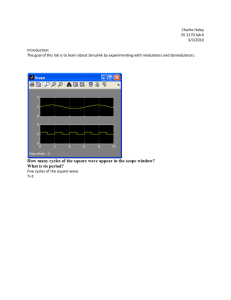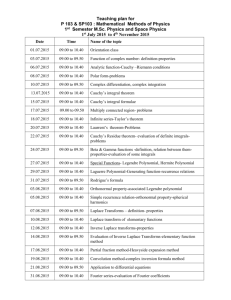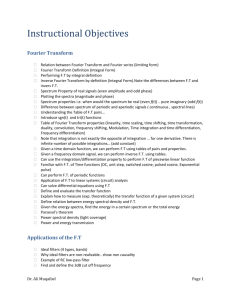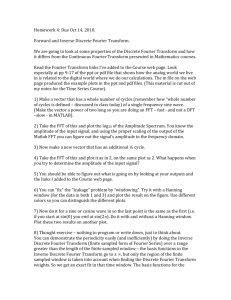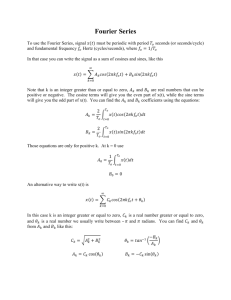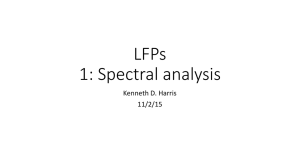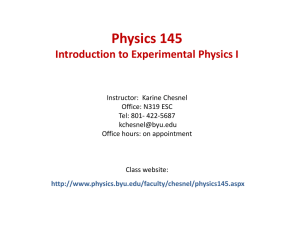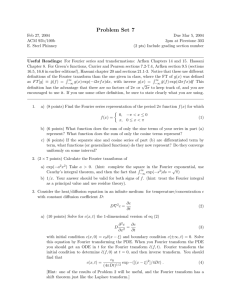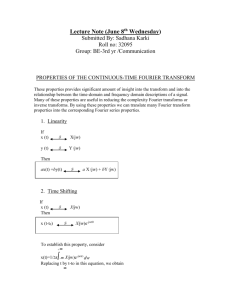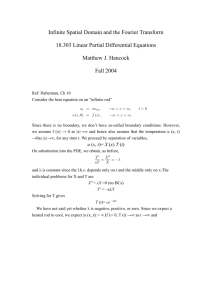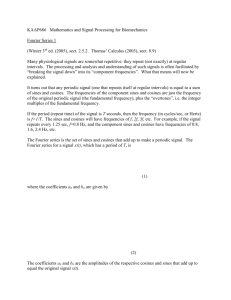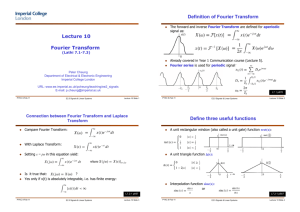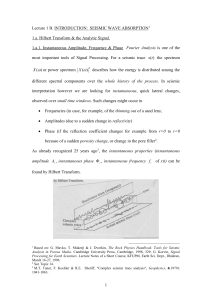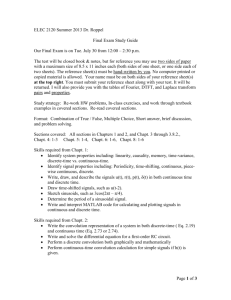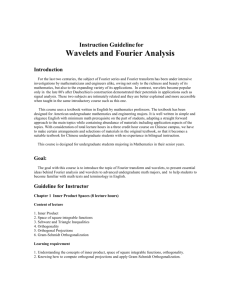documentation
advertisement
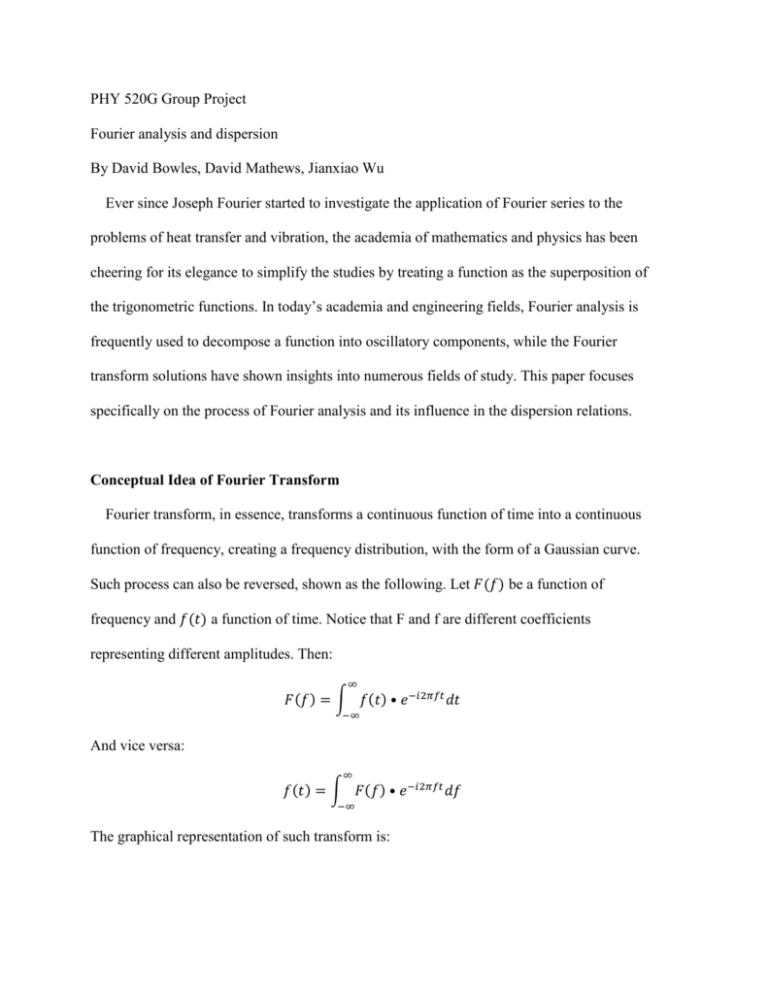
PHY 520G Group Project
Fourier analysis and dispersion
By David Bowles, David Mathews, Jianxiao Wu
Ever since Joseph Fourier started to investigate the application of Fourier series to the
problems of heat transfer and vibration, the academia of mathematics and physics has been
cheering for its elegance to simplify the studies by treating a function as the superposition of
the trigonometric functions. In today’s academia and engineering fields, Fourier analysis is
frequently used to decompose a function into oscillatory components, while the Fourier
transform solutions have shown insights into numerous fields of study. This paper focuses
specifically on the process of Fourier analysis and its influence in the dispersion relations.
Conceptual Idea of Fourier Transform
Fourier transform, in essence, transforms a continuous function of time into a continuous
function of frequency, creating a frequency distribution, with the form of a Gaussian curve.
Such process can also be reversed, shown as the following. Let 𝐹(𝑓) be a function of
frequency and 𝑓(𝑡) a function of time. Notice that F and f are different coefficients
representing different amplitudes. Then:
∞
𝐹(𝑓) = ∫ 𝑓(𝑡) • 𝑒 −𝑖2𝜋𝑓𝑡 𝑑𝑡
−∞
And vice versa:
∞
𝑓(𝑡) = ∫ 𝐹(𝑓) • 𝑒 −𝑖2𝜋𝑓𝑡 𝑑𝑓
−∞
The graphical representation of such transform is:
Source: https://en.wikipedia.org/wiki/Fourier_analysis#Interpretation_in_terms_of_time_and_frequency, Wikipedia, Fourier
analysis.
Our Project
The above example encompasses the Fourier transform in the energy space, which has the
general form of:
𝐸 = ωħ, with 𝐸̂ = −𝑖ħ
∂
∂t
Where ω is the angular frequency.
Although our project was modeled based in the momentum space, it is also able to output
the correct Fourier transform wave forms in the energy space, due to the Heisenberg
Uncertainty principle. The equivalence of the above equation in the momentum space is:
𝑃 = 𝐾ħ, with 𝑃̂ = 𝑖ħ
Where K is the planar frequency.
∂
∂x
We start with: 𝑓̂(𝐾) = ∫ 𝑑𝑥𝑒 −𝑖𝐾𝑥 𝑓(𝑥), and its inverse Fourier transform is: 𝑓(𝑥) =
∫ 𝑑𝐾𝑒 𝑖𝐾𝑥−𝑖ω(K)t 𝑓̂(𝐾). We can clean this up a little and make it: 𝑓(𝑥) =
∫ 𝑑𝐾𝑒 𝑖(𝐾𝑥−ω(K)t 𝑓̂(𝐾). To get a general solution, we can Taylor expand both K and ω(k)
about K0:
𝐾 = 𝐾0 + (𝐾 − 𝐾0 )
𝑑ω
𝑑 2 ω (𝐾 − 𝐾0 )2
(𝐾 − 𝐾0 ) +
ω(K) = ω(K 0 ) +
+⋯
𝑑𝐾
𝑑𝐾 2
2
𝑑2 ω
𝑑ω
Where ω(K 0 ) is the phase velocity, 𝑑𝐾 is the group velocity, and 𝑑𝐾2 is the dispersive rate. It
is also worth mentioning that ω =
𝐾1 −𝐾2
2
ω1 +ω2
𝑤𝑖𝑡ℎ ∆ω =
2
ω1 −ω2
2
, and 𝐾 =
𝐾1 +𝐾2
2
𝑤𝑖𝑡ℎ ∆𝐾 =
. Our equation 𝑓(𝑥) = ∫ 𝑑𝐾𝑒 𝑖(𝐾𝑥−ω(K)t 𝑓̂(𝐾) now turns into
𝑓(𝑥) = ∫ 𝑑𝐾𝑓̂(𝑘)𝑒
𝑖(𝐾𝑥−𝑡(ω(K0 )+
𝑑ω
𝑑2 ω(𝐾−𝐾0 )2
(𝐾−𝐾0 )+ 2
))
𝑑𝐾
2
𝑑𝐾
.
If we simplify it a little, it becomes:
𝑓(𝑥) = 𝑒
(𝐾0 𝑥−ω(K0 )𝑡)𝑖
∫ 𝑑𝐾𝑓̂(𝑘)𝑒
𝑖((𝐾−𝐾0 )𝑥−𝑡(ω(K0 )+
𝑑ω
𝑑2 ω(𝐾−𝐾0 )2
(𝐾−𝐾0 )+ 2
))
𝑑𝐾
2
𝑑𝐾
2
Where 𝑓̂(𝑘) = 𝑒 −𝛾(𝐾−𝐾0 ) , 𝛾 determines the certainty of a measurement in K space – it
controls the spread of the wave functions.
Let’s further simplify the equation and:
𝑑ω
𝑑𝐾
{
𝑑2ω
𝛽=
𝑑𝐾 2
𝛼=
𝑓(𝑥) = 𝑒
(𝐾0 𝑥−ω(K0 )𝑡)𝑖
∫𝑒
−𝛾(𝐾−𝐾0 )2 𝑖[(𝐾−𝐾0 )𝑥−𝑡(𝛼(𝐾−𝐾0 )+𝛽
𝑒
Let 𝑞 = 𝐾 − 𝐾0 , and the sum of the above exponents is:
(𝐾−𝐾0 )2
]
2
𝑑𝐾
𝛽
−𝛾𝑞 2 + 𝑖(𝑞𝑥 − 𝑡𝛼𝑞 − 𝑡 𝑞 2 )
2
We can complete the square:
= −𝑞 2 (𝛾 +
= −(𝛾 +
𝑖𝛽𝑡
) + (𝑖𝑥 − 𝑖𝑡𝑎)𝑞
2
𝑖𝛽𝑡 2 (𝑖𝑥 − 𝑖𝑡𝛼)
)[𝑞 −
𝑞
𝑖𝛽𝑡
2
(𝛾 + 2 )
2
= −(𝛾 +
2
(𝑖𝑥 − 𝑖𝑡𝛼)
(𝑖𝑥 − 𝑖𝑡𝛼)
𝑖𝛽𝑡 2 (𝑖𝑥 − 𝑡𝛼)
)[𝑞 −
𝑞+[
] −[
] ]
𝑖𝛽𝑡
𝑖𝛽𝑡
𝑖𝛽𝑡
2
(𝛾 + 2 )
2 (𝛾 + 2 )
2 (𝛾 + 2 )
2
= − (𝛾 +
Since
(𝑖𝑥−𝑖𝑡𝛼)2
2(𝛾+
𝑖𝛽𝑡
)
2
=
(𝑖𝑥 − 𝑖𝑡𝛼)
(𝑖𝑥 − 𝑖𝑡𝛼)2
𝑖𝛽𝑡
) [𝑞 −
] +
𝑖𝛽𝑡
𝑖𝛽𝑡
2
2 (𝛾 + 2 )
4 (𝛾 + 2 )
𝑖(𝑥−𝑡𝛼)(2𝛾𝑖(𝑥−𝑡𝛼)
4𝛾−𝛽 2 𝑡 2
=
𝛽𝑡(𝑥−𝑡𝛼)+2𝛾𝑖(𝑥−𝑡𝛼)
4𝛾2 −𝛽 2 𝑡 2
(𝑥−𝑡𝛼)2
𝑓(𝑥) =
Let 𝑢 = 𝑞 −
−[
]
𝑒 𝑖(𝐾0 𝑥−ω(K0 )𝑡) 𝑒 4𝛿+2𝑖𝛽𝑡
2𝜋
,
𝑖𝛽𝑡
∞ −(𝛾+ 2 )[𝑞−
∫−∞ 𝑒
∞
𝛽𝑡(𝑥−𝑡𝛼)+2𝛾𝑖(𝑥−𝑡𝛼)
4𝛾2 −𝛽 2 𝑡 2
𝛽𝑡(𝑥−𝑡𝛼)+2𝛾𝑖(𝑥−𝑡𝛼)
]
4𝛾2 −𝛽2 𝑡2
𝑖𝛽𝑡
2
𝑑𝑞.
2
, and the integral becomes ∫−∞ 𝑒 −(𝛾+ 2 )𝑢 𝑑𝑞. We can use
𝑣 = √𝜇𝑢
2
1 ∞
separation of variables to solve it. Let: {
, and integral becomes 𝑢 ∫−∞ 𝑒 −𝑣 𝑑𝑣 =
√
𝑑𝑣 = √𝜇𝑑𝑢
𝜋
√𝜇, where 𝜇 = 𝛾 +
𝑖𝛽𝑡
2
. Finally:
𝑓(𝑥) =
Discussion
(𝑥−𝑡𝛼)2
𝑖(𝐾0 𝑥−ω(K0 )𝑡) −[4𝛿+2𝑖𝛽𝑡]
𝑒
𝑒
𝑖𝛽𝑡
2√𝛾 + 2 √𝜋
The final equation 𝑓(𝑥) =
𝑒 𝑖(𝐾0 𝑥−ω(K0 )𝑡) 𝑒
2√𝛾+
(𝑥−𝑡𝛼)2
−[
]
4𝛿+2𝑖𝛽𝑡
𝑖𝛽𝑡
√𝜋
2
is the Fourier transform from the
momentum space to the position space. It breaks down the momentum function into super
position of series of position functions. We suspected that when completing our last integral
∞
∫−∞ 𝑒
−(𝛾+
𝑖𝛽𝑡 2
)𝑢
2
𝑑𝑞, we included the term 𝜇 = 𝛾 +
𝑖𝛽𝑡
2
, which means that if we take a finite
region Ω, and take the direction of integral as following:
III
IV
I
-M
II
Notice that the roman numerals represent the integrals on
M
the surface of the
rectangular box, and the direction of these integrals are labeled on the box itself. Because
2
𝑒 −𝑢 is a well-behaved function, meaning it is an analytic function and it dies off to zero
sufficiently quick taking the bounds with contours added to zero at infinity. Therefore:
lim (∫ 𝐼𝐼𝐼 + ∫ 𝐼) = 0, and ∫ 𝐼𝑉 = − ∫ 𝐼𝐼. We can also flip the direction of the integral for II
𝑀−∞
and make it integrate in the same direction of IV, which is exactly what Fourier transform
does, and it is our applet output.
Applet Program from Wolfram Alpha
u[x_, t_, k0_, a_] :=
1/Sqrt[1 + a*2*I*t]*Exp[-1/4*k0^2]*
Exp[-1/(4*a + I*2*t)*(x - I*k0/2)^2]
v[x_, t_, w_, k_] :=
Cos[k*x - w*t]
Animate[Manipulate[
Plot[{Abs[u[x, t, k0, a]]*v[x, t, w, k],
Abs[u[x, t, k0, a]]}, {x, -60, 60}, Axes -> {True, False},
PlotRange -> {-2, 2}, PlotStyle -> Thick,
PlotLegends -> {"Wave Packet", "Amplitude"}] , {{k, 1,
"Frequency"}, 0, 5}, {{k0, 0, "Group Velocity"}, -3,
3}, {{w, 0, "Phase Velocity"}, -5,
5}, {{a, .5, "Dispersion Rate"}, .1, 2}], {{t, 0, "Time"}, 0, 10}]


